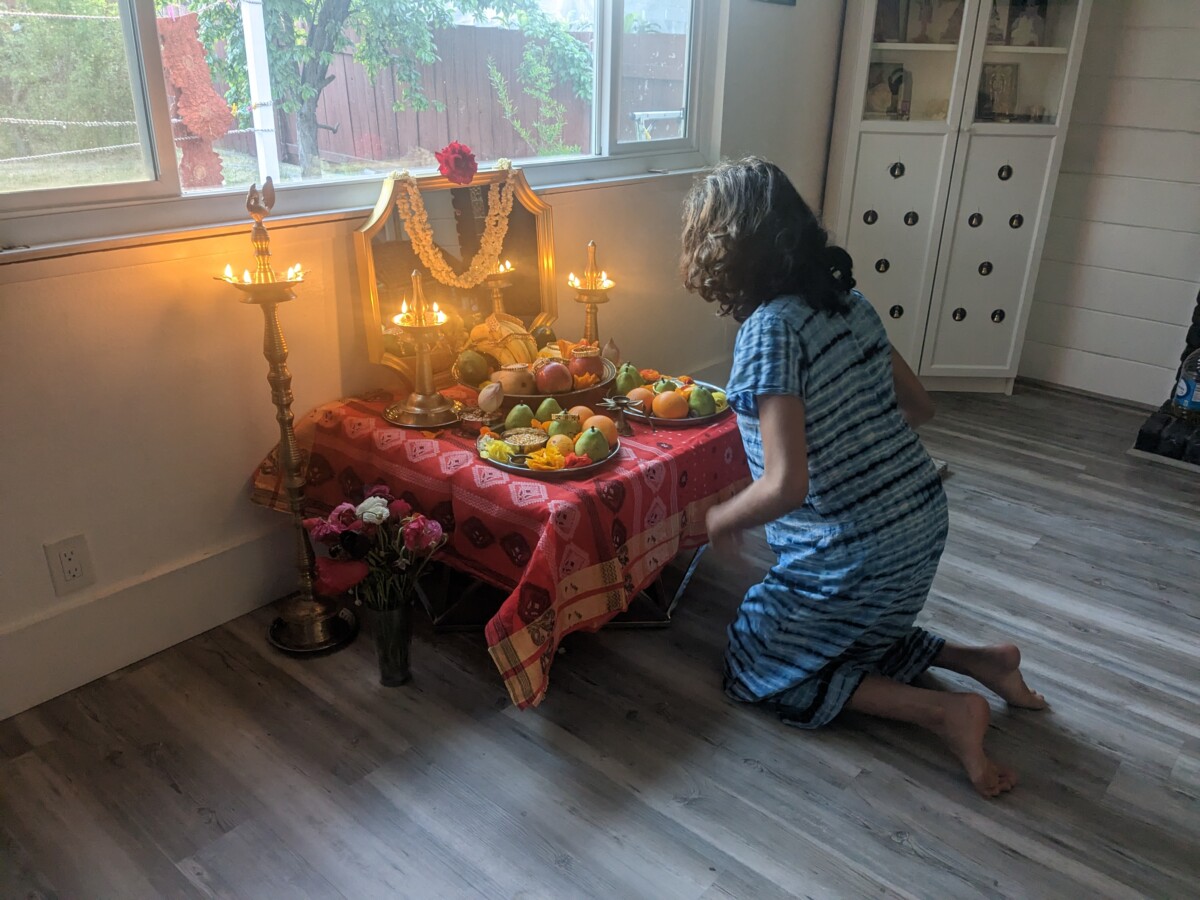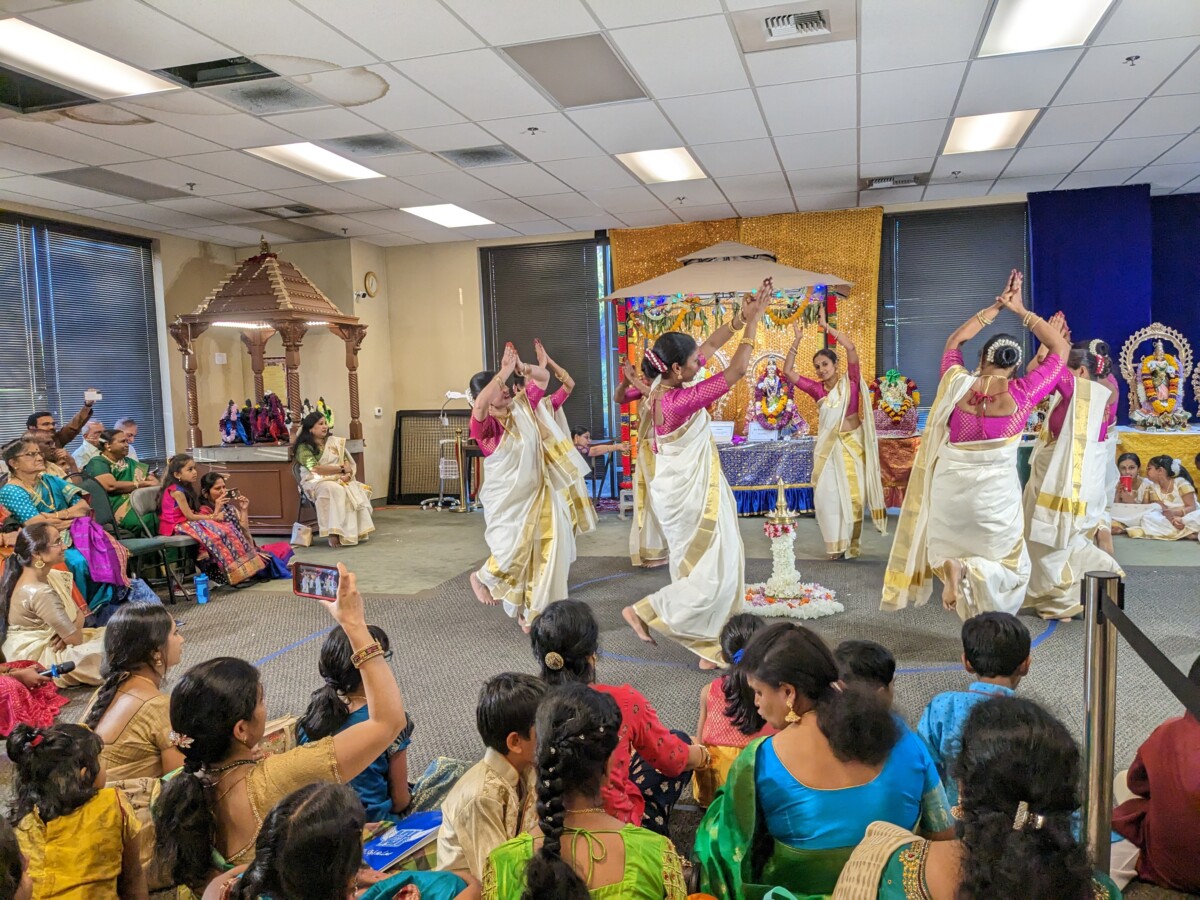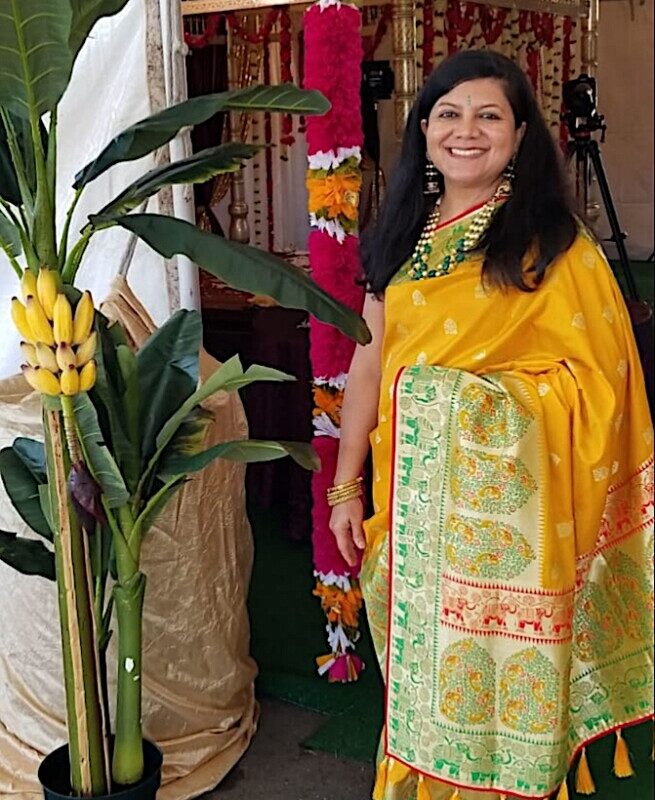
Happy Puthandu (Tamil New Year) and Happy Vishu (Kerala New Year) to all those who celebrate and mark the beginning of a brand New Year today.
Unlike the Western calendar, which celebrates the New Year on January 1st, the Hindu calendar known as the Panchang marks its New Year mostly in the Chaitra month when the Sun descends into the zodiac sign of Aries. Known as Vikram Samwat, the Hindu Solar New Year mainly falls between March and April or spring, depending on which region of India one hails from. Each New Year has a name; this year, 2081, is called Krodhi.
I love the idea of celebrating the New Year in Spring. Nature is reborn with the prolonged daylight and thriving with her spring blossoms! There is newness in the air. Every blade of grass, every flower, every creature is rejuvenated with new energy, hope, and vitality.

Our family originates in the southern Indian states of Tamil Nadu and Kerala. We celebrate the Tamil New Year, Puthandu and Kerala New Year, or Vishu. Both New Year’s generally fall on the same day since Tamil Nadu and Kerala states are adjacent and geographically within close longitudes and latitudes.
Puthandu/ Tamil New Year:
Tamil New Year, also called Puthandu ( meaning New Year), is relatively simple. We thoroughly clean the home, including the holy altar, the previous night. We wake up the following day to bathe, wear traditional clothes, and decorate the porch with an elaborate kolam (a drawing on the floor with rice powder). Next, we clean the front door, the doorway or entrance, and anoint with chandan (sandalwood powder) and kumkum (red turmeric powder). Lastly, a toran (garland) of mango leaves is strung across the top of the doorway.
Every ritual in Hinduism has scientific and symbolic significance. Mango leaves are excellent for their purifying, anti-septic properties and harbinger of good health. Mango leaves and its golden yellow fruit are considered auspicious and symbolize the Goddess of Wealth, Lakshmi. After all, health is wealth! Some homes will also use banana leaves and stems for decorations. Everywhere you look, there is festivity expressed through nature!
 Mango Tree: Photo by Rajendra Biswal on Unsplash
Mango Tree: Photo by Rajendra Biswal on Unsplash
After the decorations, we perform a simple worship, starting with the lighting of the diya / villaku ( holy lamp). The worship altar is decorated with fresh flowers. Gratitude for yet another New Year is expressed, and the entire family prays for the well-being of all. Each family will chant according to their sampradaya or traditions. Chanting brings harmony, focus, and a connection to the divine.
The most important aspect of Puthandu worship is opening and reading the brand new panchangam or almanac for the New Year. Every family receives its panchangam from an elder in the family or a local temple.
Worship is followed shortly by neivedhyam, or holy offerings to the Gods. Tamil New Year neivedhyam is typically a mango pachadi, a mouth-watering sauce of sour raw mangoes, bitter neem flowers, tangy tamarind, sweet jaggery, and spicy red chilies. This amalgamation of various tastes signifies life with its varying flavors, trials, and tribulations. Amid happiness, bitterness, sadness, and excitement lies the essence of life and our quest to understand the divinity within ourselves and others.
The mango and neem trees are indigenous to South India and fully abloom at this time of the year, with abundant golden mangoes and tiny yellow neem fruit ready to be harvested. The fresh green color of both leaves is soothing to the eyes, and due to their antibacterial nature, rural folks chew them for stronger gums. Neem leaves are very effective in cooling the body and protecting against skin diseases. The bitter neem leaves aid in cleansing the gut and also boost immunity. In short, the Puthandu mango pachadi is a tonic for kicking in great health for the upcoming year.
In the picture below, the mango pachadi is to the left of the fruits.

After worship, the family sits together and enjoys a hearty traditional Tamil meal of various veggies, sambhar, rasam, rice, vadai, and a payasam or a dessert. In South India, all this yummy food is served on a banana leaf; I try to do so. After all, no matter where we go or what we do, we seek comfort in our traditions and roots – our ancestors, families, and childhood memories. Also, by taking the time to celebrate our traditions, we pass on our legacy to our Hindu-American children, grounding them in their timeless roots as they spread their branches in the modern world.
Below is a delicious meal served on a banana leaf during one of our New Year celebrations in India.

Lastly, New Year celebrations are followed by wishing family and friends Tamizh Puthandu Vazthukkul or Happy New Year! We visit the local temple in the evening to meet with many community members and experience special worship. In Sacramento, where I live, the local Tamil American communities have elaborate celebrations with traditional performances and community get-togethers. We love attending these and spending an evening immersed in everything Tamil culture.
Vishu / Kerala New Year:
Vishu or Kerala New Year, is unique and very different from Tamil New Year. The New Year is marked by viewing the extraordinary Vishu Kani first thing in the morning to remind oneself of the Indwelling Divinity and that true wealth and abundance lie in nature.
Vishu Kani? It’s a beautifully decorated mirror surrounded by nature’s abundance.
For this, in addition to the regular cleaning and decoration of the porch the previous night, the entire family comes together post-dinner to decorate a large mirror placed on the ground or a small table. Kani set-up and decorations vary from family to family but the central idea is a decorated mirror surrounded by life’s bounty.
Vishu Kani decorations start with cleaning and anointing the mirror with chandan and kumkum. Then, the women/girls of the house get their gold jewelry, mainly necklaces, and hang them around the mirror. They can also choose flower garlands for this purpose.
Next, they surround the mirror with everything yellow and orange, like produce, flowers, grains, etc., to signify gold. It is very common to use a uruli, traditional bronze cookware, to place the mirror and other items. In our family, we place the kani items around the mirror.
Depending on availability, the produce is generally yellow and orange, including pumpkins, gourds, mangoes, bananas, apples, oranges, and yellow and orange capsicums. Next are various yellow-colored lentils, like split pigeon peas, split chickpeas, small yellow lentils, and small red lentils, neatly filled in bowls.
Finally, one places gold bangles, chains, and rings on top of the various bowls of produce and lentils. And yes! Remember to add a bowl of gold, silver, and bronze coins and brand-new crisp notes of any denomination. Some families will also keep brand-new clothes in the kani set-up. The very last step before going to sleep? Place beautiful, majestic bronze Kerala lamps next to the mirror altar. Fill them with oil and place cotton wicks in all directions. Now go to sleep!

The next morning, on the day of the New Year, the eldest woman in the house wakes up, freshens up, and heads to the Vishu Kani. She will light all the lamps and decorate the Vishu Kani with fresh yellow and orange flowers (if available) or any flower of choice. If in Kerala, one will use very special, beautiful indigenous yellow-colored Kanni Konna or Vishu kani konna flower abloom everywhere.
 Vishu Kani Flowers: Photo by COARSE + FINE on Unsplash
Vishu Kani Flowers: Photo by COARSE + FINE on Unsplash
I generally like to use flowers that grow in my backyard. In traditional celebrations, flowers and veggies grown in the garden are always used, signifying offering the fruits of one’s labor to God as prasadam.
Next, the house lady will look in the mirror and spend a few minutes gazing at herself, reminding herself of the divinity within! After this, she will wake each family member, reminding them not to open their eyes. From the eldest to the youngest, one by one, she will cover their eyes with her palm and bring them to the Vishu Kani! To follow the directions and not trip and fall is an exercise in trust!
Once stationed in front of the Vishu Kani, settle down on the floor and finally open your eyes to see yourself as the Divine in the mirror, surrounded by the abundance of nature! You are God yourself- so how would you behave the rest of the year? How would you treat others? How would you treat yourself? What decisions would you make? What words will you utter? How will you live life for the rest of this year? With kindness and compassion or anger? With positivism or negativity? With hope or lack of it?

This self-reflection and reminder of the divinity within, while looking at oneself in the mirror surrounded by nature’s abundance and lighted lamps, is central to the Vishu celebrations. Ideally, a Hindu worship altar always has a murti or a representation of one of the Gods in a photo frame with lighted lamps, jewelry, fruits, flowers, and other offerings next to a representation of God. But in Vishu, that representation is replaced by one’s face /reflection in the mirror.

The significance? A reminder of “Aham Brahma Asmi” or “I am Divine,” the core belief of Hinduism. The Hindu dharma believes that God resides within oneself, others, and every living and non-living matter. No creation exists without the Divine, and the realization of this Indwelling, ever-pervading divinity is the ultimate goal of every birth. Upon this realization, one attains moksha or liberation from karma stemming from endless cycles of birth and death. Moksha leads to union with the cosmos. The Vishu Kani, in short, is a beautiful representation/reminder of the essence of the Hindu dharma. It beckons us to start our New Year, reminding ourselves of the divinity within.
Also, all the yellow and orange produce signify that nature’s abundance is true wealth and health. Hence, protecting nature is a duty we cannot forgo. Kerala homes are generally surrounded by thick vegetation, with many varieties of fruits, veggies, and flowers. Using all of them in the Vishu Kani celebrations signifies one’s efforts to protect nature. Modern science has proved that gardening, grounding, and spending time in nature are perfect for one’s health. Vishu Kani connects all those dots, ultimately leading to the Divine.

After the entire family views the Vishu Kani, the elders bless the kids and gift them with the Vishu kannikootum, or coins and new clothes, if any. In the olden days, one gave real gold coins, a tradition that some families still follow. The kids then purchase what they want with the money!
Finally, the family gets together for Vishu sadhya, or feast, which is a traditionally prepared meal of signature Kerala dishes like olan, kalan, avial, sambhar, rasam, and desserts like payasam or paal pradhaman. There is definitely lots of cooking and eating.
Vegetables are abundant in New Year’s food prep, like this sambhar from last year’s Vishu.
 Here in Sacramento, the Kerala Hindu community gathers in large numbers for weekend celebrations. Men, women, and children dress in traditional mundu/ veshti and pavadai clothes. Women perform the conventional Kerala dance of Kaikotu Kali, a dance performed in a circle around a lighted lamp. The celebrations end with mouth-watering food prepared by community members.
Here in Sacramento, the Kerala Hindu community gathers in large numbers for weekend celebrations. Men, women, and children dress in traditional mundu/ veshti and pavadai clothes. Women perform the conventional Kerala dance of Kaikotu Kali, a dance performed in a circle around a lighted lamp. The celebrations end with mouth-watering food prepared by community members.

In short, the Tamil and Kerala New Year is an extraordinary time for our family, with festivities steeped in tradition, culture, and community. We start the New Year with the gift of our dharma, the reminder of abundance in our lives, and the wisdom of our ancients. We look forward to it every year.
Tamizh Puthandu Vazthukkul!
Vishu Aashamsakal!








































